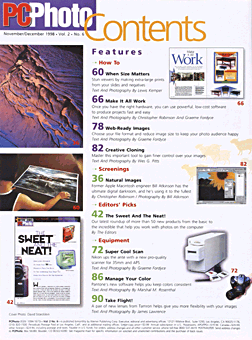
|
From the November / December 1998 Issue of PCPhoto— Former Apple Macintosh engineer Bill Atkinson has the ultimate digital darkroom, and he's using it to the fullest. Natural ImagesBy Christopher Robinson |
||
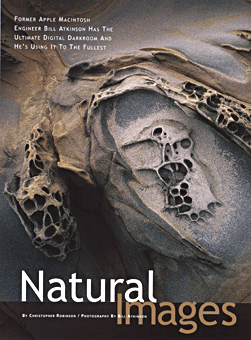
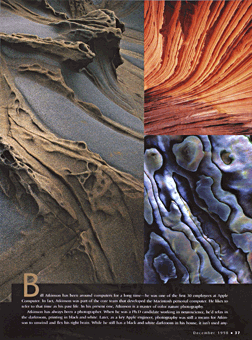
|
|||
|
Bill Atkinson has been around computers for a long time-he was one of the first 30 employees at Apple Computer. In fact, Atkinson was part of the core team that developed the Macintosh personal computer. He likes to refer to that time as his past life. In his present one, Atkinson is a master of color nature photography. Atkinson has always been a photographer. When he was a Ph.D candidate working in neuroscience, he'd relax in the darkroom, printing in black-and-white. Later, as a key Apple engineer, photography was still a means for Atkinson to unwind and flex his right brain. While he still has a black-and-white darkroom in his house, it isn't used anymore. |
These days, he's doing everything on the computer. Atkinson has a quad 200 MHz PowerPC processor Macintosh clone. It has four 200 MHz central processing units internally networked together. This arrangement gives the computer an incredible amount of processing power. It allows him to process the large files that he generates very quickly. Along with that, he has 1.5 gigabytes of RAM and a 70 GB hard disk. In contrast, the computers that we have at the PCPhoto editorial offices are in the 200 MHz range, with about 128 megabytes of RAM and 4 GB hard drives. Now our systems aren't slouches, but Atkinson's system is a dream. |
||

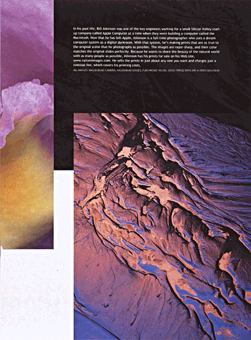
|
|||
|
He also has a Heidelberg TANGO drum scanner, which gives him 650 MB files. The scanner is capable of making larger files, but Atkinson has found that his largest prints (which are printed by Evercolor in Massachusetts) look fine from 650 MB files. Also, 650 MB is a convenient size because it fits on a CD for mailing to Evercolor. From the 650 MB file, Atkinson resizes the file depending on the end use. In his home office, there's also a Fujix Pictrography printer. The Pictrography printer isn't an inkjet; it's actually a digital enlarger that makes prints in a photographic process from the digital file. It turns out prints up to 11x14-inches. |
In his past life, Bill Atkinson was one of the key engineers working for a small Silicon Valley startup company called Apple Computer at a time when they were building a computer called the Macintosh. Now that he has left Apple, Atkinson is a full-time photographer who uses a dream computer system as a digital darkroom. With that system, he's making prints that are as true to the original scene that he photographs as possible. The images are razor-sharp, and their color matches the original slides perfectly. Because he wants to share the beauty of the natural world with as many people as possible, Atkinson has his prints for sale on his web site, www.natureimages.com. He sells the prints in just about any size you want, and charges just a nominal fee, which covers his printing costs. (sidebar) |
||
|
All Images: Hasselblad camera, Hasselblad lenses, Fujichrome Velvia, Gitzo tripod with
Arca-Swiss ballhead
|
|||

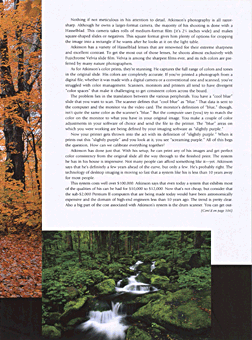
|
|||
|
Nothing if not meticulous in his attention to detail, Atkinson's photography is all razor-sharp. Although he owns a larger-format camera, the majority of his shooting is done with a Hasselblad. This camera takes rolls of medium-format film (it's 2 1/4 inches wide) and makes square-shaped slides or negatives. This square format gives him plenty of options for cropping the image into a rectangle if he wants after he looks at it on the light table. Atkinson has a variety of Hasselblad lenses that are renowned for their extreme sharpness and excellent contrast. To get the most out of those lenses, he shoots almost exclusively with Fujichrome Velvia slide film. Velvia is among the sharpest films ever, and its rich colors are preferred by many nature photographers. As for Atkinson's color prints, they're stunning. He captures the full range of colors and tones in the original slide. His colors are completely accurate. If you've printed a photograph from a digital file, whether it was made with a digital camera or a conventional one and scanned, you've struggled with color management. Scanners, monitors and printers all tend to have divergent "color spaces" that make it challenging to get consistent colors across the board. |
The problem lies in the translation between the various peripherals. You have a "cool blue" slide that you want to scan. The scanner defines that cool blue" as "blue." That data is sent to the computer and the monitor via the video card. The monitor's definition of "blue", though, isn't quite the same color as the scanner's "blue." But the computer user (you) try to match the color on the monitor to what you have in your original image. You make a couple of color adjustments in your software of choice and send the file to the printer. The "blue" areas on which you were working are being defined by your imaging software as slightly purple. Now your printer gets thrown into the act with its definition of "slightly purple." When it prints out this "slightly purple" and you look at it, you see "screaming purple." All of this begs the question, How can we calibrate everything together? Atkinson has done just that. With his setup, he can print any of his images and get perfect color consistency from the original slide all the way through to the finished print. The system he has in his house is impressive. Not many people can afford something like it – yet. Atkinson says that he's definitely a few years ahead of the curve, but only a few. He's probably right. The technology of desktop imaging is moving so fast that a system like his is less than 10 years away for most people. |
||
|
|
|||
|
This system costs well over $100,000. Atkinson says that even today a system that exhibits
most of the qualities of his can be had for $10,000 to $12,000. Now that's not cheap, but
consider that the sub-$2,000 Pentium II computers that are being made today would have been
astronomically expensive and the domain of high-end engineers less than 10 years ago. The
trend is pretty clear. Also a big part of the cost associated with Atkinson's system is the
drum scanner. You can get outstanding results with a good service bureau making drum scans
for you.
Armed with his system, Atkinson is now working with other photographers to share his knowledge and deep understanding of the digital image arena. Recently, Galen Rowell and Frans Lanting have both been learning from Atkinson. If there's a link between Atkinson's past life as a key Macintosh designer and programmer, it's in his desire to bring the capabilities of technology to people. That's what the Mac did. In 1982, I wrote my first computer program. It was on a stack of 3x5 cards that were fed into a card reader on a Hewlett-Packard computer that was bigger than a file cabinet. It took me months to learn how to write that program, which did little more than count to 10 and print the results. Two years later, I was point-and-clicking my way across a Mac screen and actually accomplishing work. |
Many traditional photographers have strong, belligerent feelings about using a computer
with photography. The misconception seems to be that the film is sacred. Once the emulsion
has an image on it, that's what you're stuck with. The fact that a print created from that
slide will exhibit a degree of degeneration is just part of the game. For Atkinson, that's
unacceptable. His digitizing process preserves the scene more than any print made from the
best slide in a traditional darkroom ever could. By making the high-end scan and then
matching the colors so precisely, his prints are closer to the "reality," of the original
scene than any conventional photograph.
All of this is the power of the computer. Rather than being a tool of trickery to fool people, Atkinson uses it to tell a greater truth. As much as he has always been a photographer, conventional enlarging has never been able to capture the scene as accurately as he can do it with a computer. With his photography, Bill Atkinson is bringing the beauty of the natural world to everyone. At his Web site, www.natureimages.com, anyone can order one of his prints. The prices are based on the size of the print, but he's only recouping the costs of printing. Check it out. PC |
||
